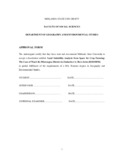Please use this identifier to cite or link to this item:
https://cris.library.msu.ac.zw//handle/11408/346| Title: | Land suitability analysis from space for crop farming: the case of Ward 36, Mberengwa District in Zimbabwe | Authors: | Hove, John | Keywords: | Land suitability Crop farming |
Issue Date: | 2014 | Publisher: | Midlands State University | Abstract: | Vegetation Condition Index (VCI), a function of Normalised Difference Vegetation Index (NDVI) forms a very critical model for climate modelling, detecting crop yield productivity and yield prediction. It approximates the weather (rainfall) component in NDVI value and allows quantifying the impact of weather (rainfall) on maize crop. The thrust of this research study was to detect land suitability potential for maize crop based on VCI-drydekads in Mberengwa District, Ward 36 in view of recurrent food insecurity in this study area. Maize crop performance is a function of critical variables which include rainfall and soil nutrients. A test of the relationship between average VCI and remotely-sensed seasonal rainfall was performed using an empirical regression model. A significant relationship (p<0,05; R2×100 > 80%) for all the five sample growing seasons was observed between mean VCI and remotely-sensed rainfall amount. Subsequently, VCI was used to detect maize crop land suitability by calculating the number of VCI-drydekads under rain-fed maize Land Utilisation Type (LUT) along with soil analysis in Geographic Information System (GIS). Results showed that Ward 36 experienced the worst maize crop failure based on the subdued VCI (%) and the high number of VCI-drydekads experienced and soil constraints hence factor rated currently not suitable (n1) and marginally suitable (s3) respectively subject to Food and Agricultural Organisation (FAO) land suitability guidelines. Based on FAO land suitability framework, VCI and soil maps which were generated for Ward 36 exposed severe limitations in terms of subdued rainfall totals and pedological constraints that yielded exceedingly high VCI-drydekads. This apparently disqualified its land suitability potential for maize crop production (LUT). The study therefore recommends that Agricultural Research and Extension Services (AREX) should evaluate the feasibility of relying on maize crop judging by the results of this research and advise resettled A1 farmers accordingly on the best diversified investment farming such as drought-tolerant varieties like sorghum and millet. Government should consider allocating bigger plots to A1 farmers for commercial livestock production (LUT) such as cattle, sheep and goats under subsidised | URI: | http://hdl.handle.net/11408/346 |
| Appears in Collections: | Bsc Geography And Environmental Studies Honours Degree |
Files in This Item:
| File | Description | Size | Format | |
|---|---|---|---|---|
| land suitability thesis-Final.pdf | 4.87 MB | Adobe PDF |  View/Open |
Items in MSUIR are protected by copyright, with all rights reserved, unless otherwise indicated.



